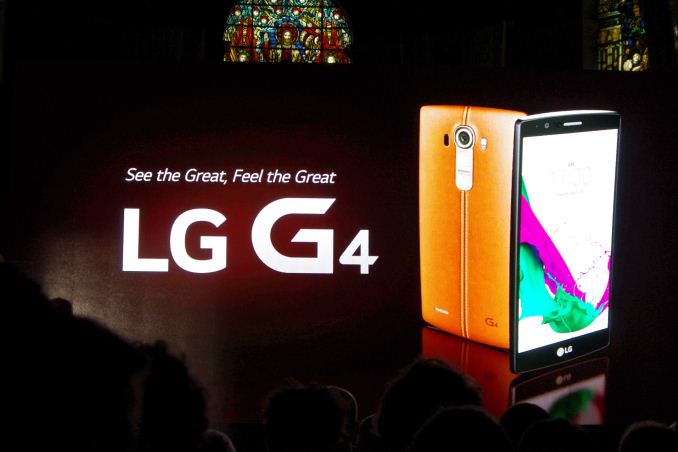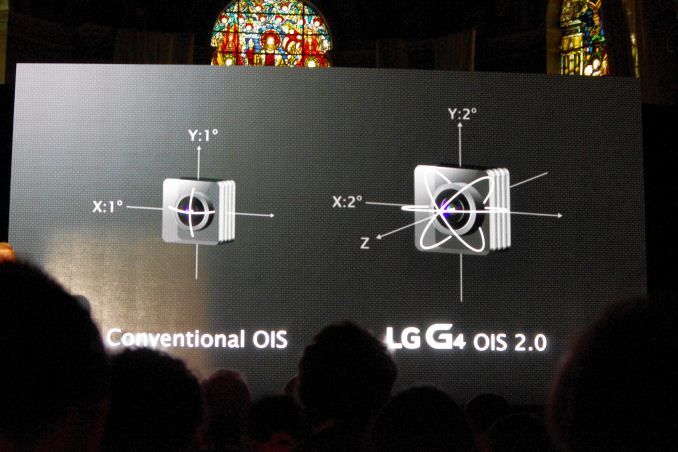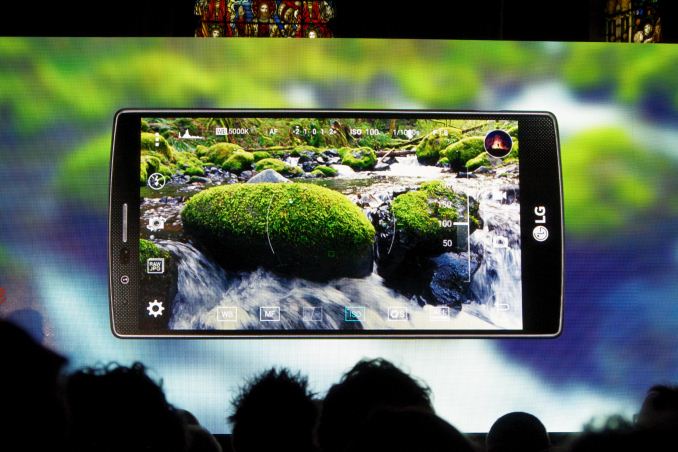LG Announces the G4: 5.5-inch QHD with Snapdragon 808
by Ian Cutress & Andrei Frumusanu on April 28, 2015 11:30 AM EST- Posted in
- Smartphones
- LG
- Mobile
- Snapdragon 808
- LG G4
- MSM8992

In a joint event between London and New York, LG has lifted the veil on the next iteration of its high-end smartphone, the G4. The G3's designs largely borrows from the G3 and iterates on it with a new slightly curved screen and optional leather back covers. The camera seems to be LG's core focus for this device, and we'll get back on those details in just a bit.
The G4 will be the first device to officially use the Snapdragon 808, Qualcomm’s MSM8992 big.LITTLE SoC arrangement that uses two ARM A57 cores in one cluster clocked in at 1.82GHz and four ARM A53s at 1.44GHz in the other. The GPU also uses a lower end Adreno 418 clocked in at 600MHz. Qualcomm avoided LPDDR4 in the S808, and thus remaines a LPDDR3 piece likely running at up to 933MHz.
While we're not too concerned with the resulting CPU performance and loss of two big cores, and slight frequency loss of the Snapdragon 808, it's the GPU which should see higher impact as 3D performance suffers a tad compared to the Snapdragon 810's Adreno 430. In our preliminary tests with the demo device, we see GFXBench Manhattan offscreen go down from 22.7fps to 15fps and T-Rex from 49fps down to 35fps when comparing the G4 to the HTC M9, which sports a FHD screen as opposed ot the QHD one we find in the LG device.
The detailed specification lists shows the iterative improvements over the G3, launched last year:
LG G3 |
LG G4 |
|
| SoC | MSM8974AC Snapdragon 801 4x Krait 400 @ 2.5 GHz |
MSM8992 Snapdragon 808 2xA57 @ 1.82GHz + 4xA53 @ 1.44GHz |
| GPU | Adreno 330 @ 578MHz | Adreno 418 @ 600MHz |
| RAM | 3GB LPDDR3 933MHz | 3GB LPDDR3 933MHz |
| NAND | 32GB NAND (eMMC 5.0) + microSD |
32GB NAND (eMMC 5.0) + microSD |
| Display | 5.5-inch 2560x1440 IPS LCD | 5.5-inch 2560x1440 IPS LCD |
| Network | 2G / 3G / 4G Qualcomm MDM9x25 UE Category 4 LTE |
2G / 3G / 4G Qualcomm X10 (Integrated) UE Category 9 LTE |
| Dimensions | 146.3 x 74.6 x 8.9 mm 149 grams |
148.9 x 76.1 x 6.3 - 9.8 mm 155 grams |
| Camera | 13MP rear camera, 1.12 µm pixels, 1/3.06" CMOS size, F/2.4. 2-axis OIS 2.1MP F/2.0 FFC |
16MP Sony IMX234 rear camera, 1.12µm pixels, 1/2.6" CMOS size F/1.8, 3-axis OIS 8MP Toshiba T4KA3 FFC |
| Battery | 3000 mAh (11.4 Wh) replaceable | 3000 mAh (11.4 Wh) replaceable |
| OS | Android 4.4.2 with LG UI | Android 5.1 with LGUX 4.0 |
| Connectivity | 802.11a/b/g/n/ac + BT 4.0, USB2.0, GPS/GNSS, MHL, DLNA, NFC | 802.11a/b/g/n/ac + BT 4.0 |
| SIM Size | MicroSIM | NanoSIM |
The screen size and resolution stay constant at 5.5" and QHD, but the device has an angular element to it, similar to the LG G Flex 2 but not as pronounced: The screen is touted to be a new generation IPS Quantum display. It looks like LG is claiming 20% gamut increase. The display has 50% increased contrast over the G3, achieving a total of 1500:1 contrast ratio. The G4 reintroduces Panel Self Refresh which was unfortunately missing from the G3, and this should vastly improve battery life over its predecessor.
The screen has a 3000mm radius curve throughout the phone's design that LG markets as "Slim Arc" design.
The phone comes in several different plastic and leather cover options. These are high-quality hand-produced genuine leather products. The plastic version sports a diamond pattern mimicking a metallic look. This also means the G4 is slightly bigger and heavier than the G3 as it comes at a increased 155g. The removable battery of the G4 remains similar to the G3 at 3000 mAh, and the SIM moves to the nano-size. The microSD slot remains an option for the G4.
The G4 gets a camera update, moving from a 13MP to a 16MP design that migrates from an F/2.4 to F/1.8, allowing for potentially better performance. We find a Sony IMX234 sensor, a unit we haven't yet seen used in any other devices. LG were keen to point the F/1.8 over Samsung’s F/1.9 on the latest Galaxy S6. The new OIS system dubbed "OIS 2.0" now offers a 3-axis gyroscope instead of the traditional 2-axis implementations in all current OIS devices. Another first is the implementation of a colour spectrum sensor next to the flash unit, and is able to read RGB and infrared light. LG is able to vastly improve white-balance and also increase clarity for more natural pictures.

The phone now also offers full manual control, with customizable ISO, exposure, shutter speed and white balance among other things. RAW format capture is also supported. Double clicking on the rear buttons already takes a picture within a second, LG is here taking another stab at Samsung's S6 as it only is able to open the camera app in the same time.
The front camera has been boosted to a 8MP Toshiba T4KA3 sensor and sports an improved gesture shot triggering function.
The volume rocker on the rear changes slightly, moving to a flatter central piece. The flash element of the camera in this area is a dual LED design, and we also find the microphone grille at the bottom. One of the elements LG seems to be pushing with the G4 is the design of the back cover, allowing for a replaceable leather rear while retaining the front facia that exhibits a faux carbon-fibre effect of sorts.
The device should be available this week in major markets. We’re currently waiting in line to get some hands-on time with the device, and hopefully on the list to get a sample to follow up from the LG G3 review.












121 Comments
View All Comments
Maxpower2727 - Tuesday, April 28, 2015 - link
You're really overestimating how much mainstream consumers care about cores. Nobody cares except for spec junkies, who again represent a very small portion of potential buyers. Go ahead, ask a random person on the street how many CPU cores their phone has. They won't know or care.jjj - Tuesday, April 28, 2015 - link
Vast majority of people care more when spending hundreds of dollars. There might be a market or two where people behave like you assume but those are just weird exceptions.Plus the number of cores is one of the few specs they think understand. Like ppl chose GPUs in prebuilt desktops based on amount of RAM.
Maxpower2727 - Tuesday, April 28, 2015 - link
I get it. You're tech-savvy. So am I. Most people are not. Most people don't "choose GPUs in prebuilt desktops based on amount of RAM." They buy the nice shiny thing that looks good in the store, which was recommended to them by the equally uninformed Best Buy employee. I don't know where you're getting the notion that average consumers care about advanced technical specs, but I assure you that they don't. You clearly spend most of your time with technologically-inclined people. That's great, but it also seems to have left you with a lack of perspective regarding the population at large.jjj - Tuesday, April 28, 2015 - link
They actually do buy like that, seen it a lot of times lol. The GPU's model number doesn't mean anything and they have no clue what things like screen resolution mean but they know that more RAM is better.Look at Mediatek last year, it made a killing by going 8 cores and forced Qualcomm to follow.
The average global consumer makes a bit of an effort even when buying a 100-200$ phone , so even more so when spending 600-1000$ (depending on location). Unless they buy on brand and then Apple is the first choice and Samsung second.
serendip - Tuesday, April 28, 2015 - link
MediaTek with 8x A7 tiny cores... A slightly batty idea, I have no idea what Android apps can take advantage of that many cores. The cheap phones that use these chips are decently fast though.name99 - Wednesday, April 29, 2015 - link
Oh don't be stupid. The best selling phone in the world has TWO cores, and that doesn't seem to have hurt Apple any. Probably because if I asked every single one of my non-tech friends how many cores are in their iPhone they wouldn't even understand the question.You even admit then when you start throwing in your idiotic "buying on brand". So basically your argument is
"people really care about cores --- except when they don't, which I will call 'buying on brand'"?
Maybe LG is more interested in selling to this 'buying on brand' population because they represent 99% of potential customers?
As for Mediatek, since Mediatek does not sell to consumers, your argument is meaningless; it's like claiming that Windows Phone will do great because Azure is so awesome. Azure may well be awesome, but 99% of people buying a Windows Phone have no idea what it is, and it doesn't affect their purchase in the slightest.
lilmoe - Tuesday, April 28, 2015 - link
Tech junkies aren't worried about the "number of cores" either. They're worried about both real performance (single AND multi-threaded performance and battery life) , and perceived performance (UI responsiveness and overall feel).The internet is full of wannabes though.
player911 - Monday, May 4, 2015 - link
Most carriers don't even list processors. They just say quad core or 64bit. This being a hexacore (2big+4little). Still a step in the right directionSoC-IT2ME - Tuesday, April 28, 2015 - link
iPhone has 2 cores - guess what...it sells like nothing else.Cores are not the issue, Marketing is.
name99 - Wednesday, April 29, 2015 - link
Marketing is not the issue EITHER. We have been through this before, how low Apple marketing spend is compared to their competitors. The issue is offering features of value to customers.You wouldn't think this is rocket science, but read the comments in this thread (and every other phone thread) and it soon becomes apparent that there is a HUGE pool of people who are utterly unwilling to accept this basic fact, even after 8 years of iPhone evidence (and maybe 7 years or so of iPod evidence before that).